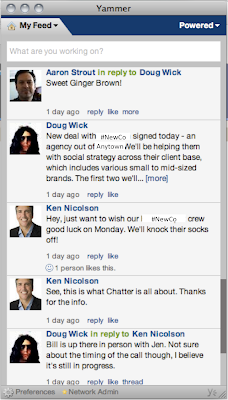 The reason I'm revisiting the topic is because our company (which is now a combination of four companies) is experiencing a renaissance of Yammer and it's bringing new and valuable results. I also thought I'd help my Twitter friend, Charlie Browning, provide some answers to his company who is asking questions like:
The reason I'm revisiting the topic is because our company (which is now a combination of four companies) is experiencing a renaissance of Yammer and it's bringing new and valuable results. I also thought I'd help my Twitter friend, Charlie Browning, provide some answers to his company who is asking questions like:- How does Yammer complement other communications channels?
- What kinds of conversations take place there?
- How does Yammer differ from other collaboration tools? E-mail? Wikis?
Of course these are all great questions and to be honest, I'm not sure I have all the answers. But here's what I can tell you from having worked at two different companies that have used internal collaboration tools including wikis, an employee community, Basecamp and of course Yammer.
Complementing other communication channels
In my almost two year experience with Yammer, the channel that most closely approximates it (other than Twitter which is public) is e-mail. And while I do sometimes use the two channels interchangeably, the two questions I ask before doing either is: 1) is this information critical -- if so, it goes in e-mail because I can't afford for key individuals to miss it and 2) would other people who aren't the target of the message benefit from the update? Things that fall into this second category are PR wins, general announcements (sandwiches in the kitchen), requests for expertise (anyone have a contact at company X) or customer wins.
How is Yammer different than other collaboration tools?
Because Yammer (like Twitter or Facebook status updates) is life streaming, it's not a particularly good place to store documents. Wikis or project management tools like Basecamp are much better places for that material. They have version control, checkin/checkout capability for documents and robust admin privileges. In a perfect world, a company might have an employee community but having run one for a bit, I can tell you that maintaining one (well) can be a ton of work. One other important note is that Yammer is not secure. That doesn't mean that like Twitter, anyone can see your stream but rather that your company might want to be careful about just how much they share on Yammer. This means financials, highly confidential information and perhaps clients full names should be kept on the down low.
The X-factor (especially for distributed companies)
One of the things I like the most about Yammer is that it's serving as a virtual employee directory for us across our four offices. That includes cell phone numbers, titles, org charts, e-mail addresses and of course a pic (should one chose to show their handsome or pretty face). Having this information in a central location that's easy to access via any computer OR mobile phone is incredibly helpful, especially when one is on the road. There's also a yammer desktop application that makes seeing peoples streams easy. By the way, if you're wondering about functionality on Yammer, it works much the same way that Twitter does where you can @ people, DM them, hashtag topics and even follow people or groups.
Is your company using Yammer? If so, how are they using it? What have the benefits or downsides been? Feel free to chime in in the comments section below.
Note: the title of this post was inspired by a concept that friend and former Forrester analyst, Ron Shevlin, shared with me while I was at Fidelity Investments back in the early 2000's. The idea centered around "right-channeling" or focusing on communications with one's customers in their channels of preference (with more than a nod toward keeping an eye on cost benefit analysis). To this day, that concept is still one of my favorites.
I've heard they host it themselves. For internal communications that can be very crucial to business, that is sort of weird and very hard to pass by IT.
ReplyDeleteI wish more companies used it or something similar though. It could avoid a lot of confusion.
Michelle - yes, Yammer is Saas vs. being installed behind the firewall. While this does make some companies uncomfortable AND limits the level of detail folks should share on Yammer, it also makes logging in across numerous locations (or on mobile) a little less cumbersome. There are products that allow for install behind the firewall but my understanding is that they are a little "out of the box."
ReplyDelete